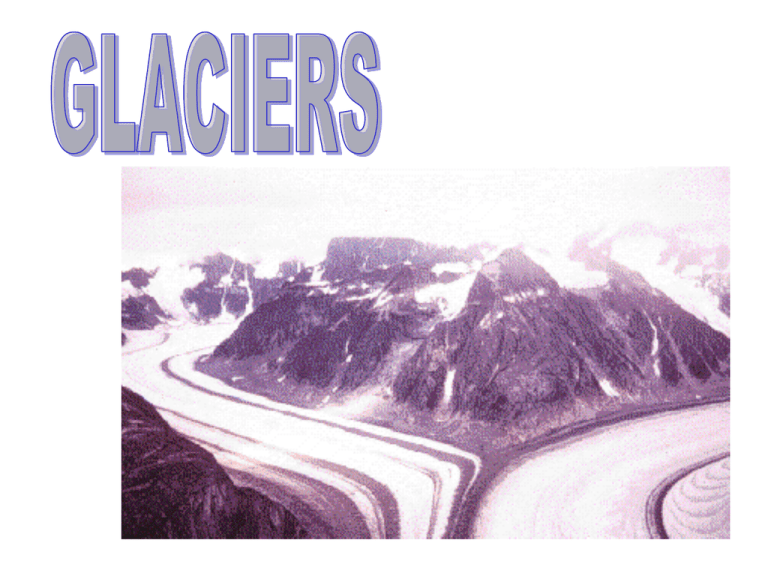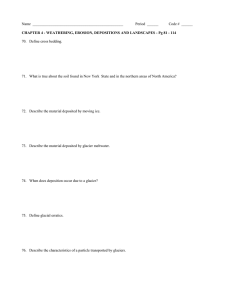Document 16059480
advertisement

Glacier Mass Budget Accumulation: How? Addition of ice to the glacier Snowfall, Freezing Rain, Avalanches Ablation: How? Removal of ice from the glacier Surface or basal melting, evaporation, sublimation calving or wind blow) Snowline: Altitude above which there is net snow accumulation Latitudinal Variation in Snowline Equator: Snow only at highest altitudes 0 to 25°N or S: Snowline lowers with latitude 25 to 30°N or S: Snowline rises again due to dryness 30 to 50°N or S: Snowline drops regularly 50 to 70°N or S: Snowline drops rapidly (cold and humid) Polar Regions: Snowline at sea level but glaciers inactive (dry) Positive Budget (Accumulation) Negative Budget (Ablation) North America: nucleation in Labrador (high snowfall/cool summers) and Keewatin (cold reasonable snowfall). No glaciation in Alaska due to dryness. Pleistocene glaciation occurred further north in Europe than in NA Why ? Warming influence of the Gulf Stream Glacier Formation and Morphology Glacier Stratigraphy (See Lecture 1) Glacier Mass Budget and Morphology Thermal Classification of Glaciers: A A. Temperate Glaciers: - Warm ice throughout - Upper active layer is thick - Meltwater percolates and refreezes - Percolation maintains ice at pressure melting point (latent heat of phase change) - Deeper ice colder than shallower ice - Heat from below cannot be conducted: melts at base B B. Polar Glaciers: - Cold ice in inner layer - Thin active layer - Thick firn in accumulation zone (high pressure metamorphism only) - Frozen to the bedrock unless thick enough for basal melting (adjacent zones still frozen; see C) C Morphological Classification of Glaciers Valley Glaciers Ice Streams Reticular Glaciers Outlet Glaciers Alpine Glaciers Cliff and Reconstituted Wall-Side Glaciers Cirques and Aretes Apron Glaciers Ice Sheets Continental Ice Sheets Ice Caps Plateau Glaciers Highland Ice-sheets Lowland Glaciers Piedmont, Expanded Foot, Fringing and Stagnant Glaciers ICE SHEETS: Large, unconfined masses Flow in irregular radial fashion from central ice domes Multiple domes are possible Only somewhat affected by underlying bedrock CONTINENTAL ICE SHEET Continental-sized dome with few nunataks (eg. Antarctica/Greenland) Greenland Ice Sheet Nunataks ICE CAPS: Dome-shaped or flat ice-sheets with nunataks. Ice Cap (Vatnajokull, Iceland) Plateau Glaciers: Flat ice-sheets on highland plateaus Tongue-like ice cascades often along edges Nunataks at margins (Eg. Iceland and mountains of Norway) Highland Ice-sheets: Broad ice-sheets at high altitude Undulating surfaces due to bedrock morphology Many isolated nunataks (Eg. Canadian Rocky Mountains) Ice Stream: Ice stream (Greenland) Long, slender, fast-moving ice mass within a continental ice sheet VALLEY GLACIERS: Elongated and streamlike glaciers in valleys Flow is confined by the valley walls Reticulated Glacier: - A valley glacier almost like an ice sheet but with flow channeled by the underlying bedrock - Can be thought of as a step toward a valley glacier from an ice stream Outlet Glacier: - An emegence of a glacier downward from a higher ice sheet or through valleys Outlet Glacier (Vatanajokull, Iceland) Alpine Glacier Mountain glaciers confined within bedrock valleys 1. Simple (one valley) 2. Dendritic (main glacier joined by secondaries) 3. Hanging (tributaries reach valley/glacier at higher elevation) 4. Composite (various glaciers join bur keep identity) Simple Alpine Glacier Hanging Glacier Cliff and Reconstituted Glacier: Forms on a slope too steep to hold ice Ice falls to the bottom of the cliff and is reconstituted Cirque: Masses of ice in small, confined bedrock alcove Name derived from the fact that they sometimes take on circular or oval shapes Cirques (Grand Tetons) Apron Glaciers: Thin masses of snow and ice on mountainsides Apron Glaciers (Mt. Adams, Washington) Lowland Glaciers Piedmont and Expanded Foot Glaciers: - Form where valley glaciers spread out onto flatter areas - Piedmont glaciers are gently-sloping and multilobate Fringing Glaciers: - Remnants of shelf-ice forming a belt along sea coasts Stagnant Glaciers: - Hummocky, debris-laden terminal zones of glaciers - May support vegetation Piedmont Glacier (Malaspina Glacier, Alaska) Piedmont Glacier Stagnant Glacier Glacier Movement “Glaciers move on their own, flowing to reach a gravitational equilibrium form, with material moving from the accumulation to the ablation zone” SLOW: MID-SPEED: FAST: FASTEST: Polar or debris-laden temperate glaciers Temperate glaciers move a few centimetres per day Glaciers on steep slopes Outlet glaciers can reach 80m/day Cliff fall Summer: Fastest movement in ablation zone Winter: Fastest movement in accumulation zone Movement is non-uniform, occurring when pressure overcomes frictional resistance of ice and obstacles further along path of movement River-like movement - valley glaciers slowest at flanks and along the base - fastest at centre and along the surface - box-shape flow profile during surges with shearing near (but not at) the confining wall Flow in regular, U-shaped valley Block flow of a surging glacier Flow in an irregularlyshaped valley Forces in Glacier Movement 1. Internal stresses from weight of own material (Most important) 2. Expansion and contraction due to internal temperature fluctuation (bending/breakage) Freeze-thaw processes enhance glacier movement 3. External forces where a glacier meets the sea (winds, waves, tides and currents) Brittle deformation dominant in surface layers Plastic deformation dominant at greater depth Glacier Movement A. Intergranular adjustments in snow and firn B. Downward water movement followed by refreezing (within glacier or downslope) C. Slippage in glaciers at pressure melting point. (Movement enhanced by soft, wet sediment at base) Slippage perpendicular to c-axis D. Internal slippage along fractures, especially near terminus (thrust faulting) Mechanisms of Glacier Movement Movement of Ice Sheets Melting at base reduces friction allowing movement 1. Movement slow at centre due to low precipitation and the lack of melting 2. Margins are most active since there is higher precipitation and melting 3. Polar glaciers can be frozen to the bed (move through internal deformation) 4. Portions of glaciers move faster than others (ice streams) Extending and Compressive Flow Glaciers move faster on steep slopes This causes tension in upper reaches (pulling) and compression in flatter, lower portions Extending flow on slopes helps to pull upstream portions Compressive flow may cause thrust faults if tension exceeds brittle strength of ice Thrust faults at terminus affects composition of moraines (sediments thrust upward from bottom of glacier) Thrust faults may form against stagnant parts of ice sheet or valley glacier (inset) due to compressive flow. Crevasses may form in extending flow. Crevasses Bergschrund crevasse: Forms at the head of a valley glacier as it slides from the headwall Transverse Crevasse: Faster part of glacier pulls away from slower part due to a change in slope Marginal Crevasse: Tensional stresses develop due to the difference in speed between the centre and the sides of a glacier Splaying Crevasse: Tensional stresses develop due to radial flow as a glacier expands into a wider part of a valley or an outlet In all cases, poorly-sorted sediment may accumulate in crevasses (crevasse fillings), forming small, elongated hills after melt.






